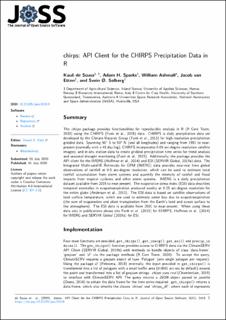chirps: API Client for the CHIRPS Precipitation Data in R
Peer reviewed, Journal article
Published version
Permanent lenke
https://hdl.handle.net/11250/2733478Utgivelsesdato
2020Metadata
Vis full innførselSamlinger
Sammendrag
The chirps package provides functionalities for reproducible analysis in R (R Core Team, 2020) using the CHIRPS (Funk et al., 2015) data. CHIRPS is daily precipitation data set developed by the Climate Hazards Group (Funk et al., 2015) for high resolution precipitation gridded data. Spanning 50◦ S to 50◦ N (and all longitudes) and ranging from 1981 to nearpresent (normally with a 45 day lag), CHIRPS incorporates 0.05 arc-degree resolution satellite imagery, and in-situ station data to create gridded precipitation time series for trend analysis and seasonal drought monitoring (Funk et al., 2015). Additionally, the package provides the API client for the IMERG (Huffman et al., 2014) and ESI (SERVIR Global, 2019a) data. The Integrated Multi-satelliE Retrievals for GPM (IMERG) data provides near-real time global observations of rainfall at 0.5 arc-degree resolution, which can be used to estimate total rainfall accumulation from storm systems and quantify the intensity of rainfall and flood impacts from tropical cyclones and other storm systems. IMERG is a daily precipitation dataset available from 2015 to near-present. The evaporative stress index (ESI) data describes temporal anomalies in evapotranspiration produced weekly at 0.25 arc-degree resolution for the entire globe (Anderson et al., 2011). The ESI data is based on satellite observations of land surface temperature, which are used to estimate water loss due to evapotranspiration (the sum of evaporation and plant transpiration from the Earth’s land and ocean surface to the atmosphere). The ESI data is available from 2001 to near-present. When using these data sets in publications please cite Funk et al. (2015) for CHIRPS, Huffman et al. (2014) for IMERG and SERVIR Global (2019a) for ESI.
Beskrivelse
Authors of papers retain copyright and release the work under a Creative Commons Attribution 4.0 International License (CC BY 4.0).

